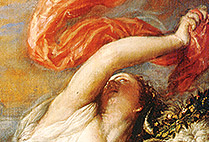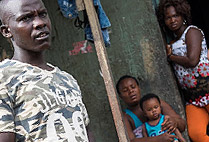Fiction
Invisible Beasts
Sharona Muir (GRS’80)
Bellevue Literary Press

In a literary world increasingly arranged in tidy genres, Muir offers up a wild and woolly hybrid that refreshingly defies classification. Compelling throughout, this whimsical, wise guide to “the animals that go unseen among us” begs to be read aloud and can be digested front to back as a novel, but would prove equally enthralling cracked open at random. The personal bestiary of an amateur naturalist named Sophie, the narrative plumbs the dogged discoveries of a girl whose gift is known to her quirky family. But even they need convincing, and the narrative capitalizes on all Sophie’s hyperalert senses as she navigates and reports on a parallel landscape crackling and thrumming stealthily through lush fauna, clinging to the undersides of visible creatures or burrowing along the urban infrastructure. Invisible Beasts toys with us, winking at the reader as it indulges the writer’s love of wordplay as much as her infatuation with, and delicate observation of, her natural surroundings; it’s the literary lovechild of Lewis Carroll and Rachel Carson filtered through the lens of zoology’s godfather, Darwin himself.
The book, which, its author confesses, “began as an experiment,” is divided into sections for common invisible beasts (the Pluricorn, Truth Bats), imperiled and extinct invisible beasts (the Foster Fowl, Beanie Sharks), rare beasts (the Hypnogater, the Oormz), invisible beasts in print (Fine-print Rotifers), and cyclically invisible beasts, the only representatives of which are Beacon Bugs, a firefly species that is invisible over 29-year periods until “they produce one generation that outshines every other firefly species.” How lovely it would be if some (but most certainly not all) of these beasts existed (assuming they don’t; they’re invisible, after all). The narrator is especially taken by Truth Bats (it’s a pity they’re invisible, she says, “because they’re so cute…”). Truth Bats will only adorn the hair or clothes of a truthful person. The bats’ chatter, a background to our speech like “the tingling echo of a waterfall just before your ears catch it,” is the “ring of truth.” “Your bats depart, scattering into the air as you trot out some whopper of a lie, your voice loses its reassuring background,” Sophie tells us, “and people feel that.”
Some of the creatures are poignant; a common invisible beast, the Couch Conch, appears in humans’ bedrooms the morning after vigorous lovemaking (mollusks are full of lessons; they know all about the balance of hard and soft, rigidity and acceptance). And then there’s the evolutionary marvel the Wild Rubber Jack, “evolved for the urban niche of business districts.” The “Jack, for brevity’s sake,” she writes, “is an invisible American Ass…American Mammoth Jacks can stand as tall as a man. To this day, we lead the world in the enormous size of our asses.”
Muir concludes her eclectic romp on a note of faith. After a meditation on communing with an invisible dog, she asks, “What is love?” Finally, she writes, “We are led to embrace a mystery too great to encompass, as unending as nature, because it is nature, the endlessness of the universe itself—that ultimate, unimaginable, ungraspable wholeness in which we are born and die, that haunts every intimacy.” Susan Seligson
Poetry
Selected Poems
Christopher Bursk (GRS’66,’75)
FutureCycle Press

A multiple award–winning poet for many decades, Bursk devotes much of his collection to ironic scrutiny of his chosen profession. Lacing his verse with searing wit and wreaking gleeful havoc with words and even individual letters, he is also adept at plunging a dagger squarely into the reader’s heart. Selected Poems opens with a kind of metameditation on a livelihood that, like the word market in The Phantom Tollbooth, puts a price on alliteration and simile, a business that offers crumbs for couplets. Crafting found verse from the names of publications that have turned him down—“Adastra, Anabiosis, Anhinga, Apalachee, Aquariaus, Axe Factory”—he asks himself, “Why do I keep writing?” He responds by noting the poet’s toughness and code of honor, and finally turns to nature: “While I have been dawdling, the trees have been busy revising. The light’s the only critic they can trust.” Bursk’s powers of observation are incisive yet humane, as in “The Pathetic Fallacy,” when he describes a paraplegic professor clutching his chest as a young Bursk helps him into a car:
but he was only grasping for one of those
notebooks
he’d go nowhere without,
like a lung he carried in his breast pocket,
another way of breathing….
Some of the poems beg to be read again and again. An incantation of aching beauty, “Prayer” pays homage to a god not of pain and disease but a “God of lucky alignments, God of the condom a thirteen-year-old rolls and unrolls on his thumb,” a God of “the hand on an inner arm,” “God of long vowels that linger in our mouths.” The poem concludes with a mantra of what it means to be acutely, defiantly human:
God of such beautiful approximations,
a saying yes, that will have to do,
to see it, feel it. Yes,
that will do. SS
The Forage House
Tess Taylor (GRS’06)
Red Hen Press
 Taylor’s BU professor, former US Poet Laureate Robert Pinsky, praised the “poise, candor and reach” of the poems in The Forage House. The descendant of Virginia slave owners, Taylor writes verse that manages to confer fragile immortality on the shreds of extinguished lives, of the Scottish ballads her grandmother “carried in her ears,” of the vague detritus—“two pipe stems, seeds, three greening buttons”—excavated at an archaeological dig on a ridge near Monticello. She writes, for example,
Taylor’s BU professor, former US Poet Laureate Robert Pinsky, praised the “poise, candor and reach” of the poems in The Forage House. The descendant of Virginia slave owners, Taylor writes verse that manages to confer fragile immortality on the shreds of extinguished lives, of the Scottish ballads her grandmother “carried in her ears,” of the vague detritus—“two pipe stems, seeds, three greening buttons”—excavated at an archaeological dig on a ridge near Monticello. She writes, for example,
of lives held here that now vanish off
like blue smoke plumes I suddenly
imagine –
which are not, will not, cannot be enough.
Taylor’s poems are haunted by the ghosts of slave owner and enslaved, of crude early photos—“All specific faces blurred”—hinting at times of Ladies’ Academies, when shoddy acreage was granted to slaves “for purposes of church and school.” In “Home of the Taylors,” she writes of the “legend built on silence” that simmers in the land beneath a subdivision and a Comfort Inn. Her many turns on the poignant, random flotsam of past lives take a darkly comic turn in “Antiques Roadshow,” in which the ampersands, which turn up in several of her poems, seem to ramp up the irony:
…In the pavilion experts finger
a child’s chair, hand-hewn & much
mended –
& question: What’s it worth? & question:
Will it sell?
Child of boomer-era seekers who, as the poem “Wedding Album 1977” recounts, married just as she prepared to emerge from her mother’s womb, Taylor expresses in “Song for El Cerrito” a longing for all that horrified her—the grid planning, the “power lines sawing hillsides”—of her working-class youth:
Now I want even the bad wood siding
in our living room & my mother’s aging
books on modern Indian thought.
The Forage House publisher’s notes inform us that Taylor’s poems reflect years of travel and dogged research, referring to her verse as forming “a lyric journalism.” As a reporter, she has an eye for the smallest, most strenuous detail. As a poet, she also honors all that we don’t and can’t know. SS















































 Taylor’s BU professor, former US Poet Laureate Robert Pinsky, praised the “poise, candor and reach” of the poems in The Forage House. The descendant of Virginia slave owners,
Taylor’s BU professor, former US Poet Laureate Robert Pinsky, praised the “poise, candor and reach” of the poems in The Forage House. The descendant of Virginia slave owners,
Related Stories
Award-Winning Poet New Creative Writing Program Director
Karl Kirchwey hopes to build connections across the University
Nobel Laureate Derek Walcott (Hon.’93) Dead at 87
Taught at BU, founded Boston Playwrights’ Theatre
Former Poet Laureate Pinsky Designs Anthology for Aspiring Poets
CAS prof’s book offers “ways to learn from the poetry of the past”
Post Your Comment